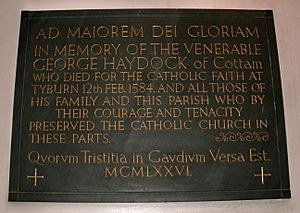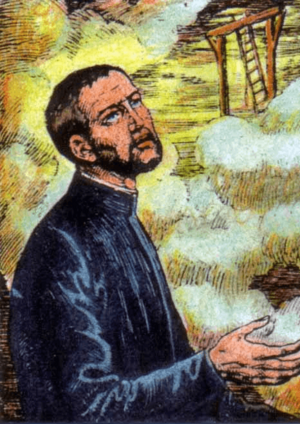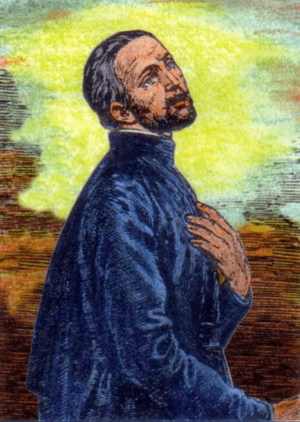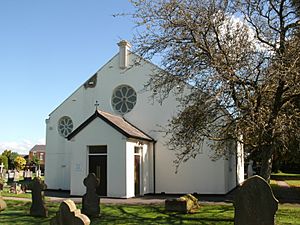George Haydock facts for kids
Quick facts for kids BlessedGeorge Haydock |
|
|---|---|

Plaque honouring Blessed George Haydock in St. Andrew's & Blessed George Haydock's Catholic Church, Cottam, Lancashire, UK.
|
|
| Martyr | |
| Born | c. 1556 Cottam Hall, Preston, Lancashire, England |
| Died | 12 February 1584 Tyburn, London, England |
| Venerated in | Roman Catholic Church |
| Beatified | 22 November 1987 by Pope John Paul II |
| Feast | 12 February (individual with companions) 22 November (together with Eighty-five martyrs of England and Wales) |
George Haydock was an English Roman Catholic priest who lived a long time ago. He was born around 1556 and died on February 12, 1584, in Tyburn, London. He is known as a Catholic martyr, which means he died for his religious beliefs. In 1987, he was declared "Blessed" by the Catholic Church. He is a different person from his relative, George Leo Haydock, who was also a priest.
Contents
Who Was George Haydock?
George Haydock was the youngest son of Evan Haydock and Helen Westby. His family lived at Cottam Hall in Lancashire, England. After his mother passed away, his father, Evan, decided to study to become a priest. He went to the English College, Douai in France.
Becoming a Priest
George and his brother Richard followed their father to Douai. George later moved to the English College, Rome in Italy. He became a priest on December 21, 1581, likely in a city called Reims.
What Happened When He Returned to England?
George Haydock arrived back in England in January 1582. At this time, being a Catholic priest in England was very dangerous. The government did not allow it.
His Arrest and Imprisonment
Around February 4, 1582, George was visiting an old friend named Hawkinson. This friend, who used to be Catholic, had changed his beliefs. He told people who hunted priests about George. George was then arrested.
He was held in the Tower of London for over a year. During this time, he was very sick with a fever. Even while in prison, he showed his strong faith. He would draw the Pope's name and symbols on his cell walls. He always stayed loyal to the Pope's spiritual authority.
His Trial
On January 16, 1584, George and other priests in the Tower were questioned. They were asked about their beliefs. George bravely stated his faith. He was forced to declare that he believed the queen was a heretic, which was seen as a serious crime against the queen. This decision sealed his fate.
On February 5, 1584, George was accused along with eight other priests. They were charged with planning against the queen. This was based on their travels and studies abroad.
Who Were the Other Priests?
Two other priests, Thomas Hemerford and John Munden, were tried with George Haydock. They also faced serious charges for their faith.
Thomas Hemerford
| Blessed Thomas Hemerford |
|
|---|---|
 |
|
| Martyr | |
| Born | c. 1553 Dorsetshire, England |
| Died | 12 February 1584 (aged 30 - 31) Tyburn, London, England |
| Honored in | Roman Catholic Church |
| Beatified | 15 December 1929 by Pope Pius XI |
| Feast | 12 February |
Thomas Hemerford was born around 1553 in Dorsetshire. He studied at St John's College, Oxford. He later became a priest in March 1583. He arrived in England in June of that year.
He was arrested when someone recognized him as a priest. He was imprisoned and later accused of plotting against the Queen. Thomas was found guilty on February 7, 1584. He was executed on February 12, 1584.
John Munden
| Blessed John Munden |
|
|---|---|
 |
|
| Martyr | |
| Born | c. 1543 Manor of Coltley in Dorset |
| Died | 12 February 1584 (aged 41 - 42) Tyburn, London, England |
| Honored in | Roman Catholic Church |
| Beatified | 15 December 1929 by Pope Pius XI |
| Feast | 12 February |
John Munden was born in Dorset. He went to Winchester College and New College, Oxford. He later became a schoolteacher. In 1580, he went to study to become a priest.
He returned to England in August 1582. In February 1583, he was recognized and arrested. He was questioned and then sent to the Tower of London. John was found guilty of plotting against the Queen on February 6, 1584.
James Fenn and Thomas Hemerford were also declared "Blessed" by the Catholic Church in 1929. Their feast day is February 12.
His Final Moments
On Wednesday, February 12, 1584, George Haydock and the four other priests were taken to Tyburn. Tyburn was a place in London where executions happened. George, being the youngest and weakest, was the first to face his fate. All of them were executed for their beliefs.
See also
- Catholic Church in the United Kingdom
- Douai Martyrs
- James Fenn


